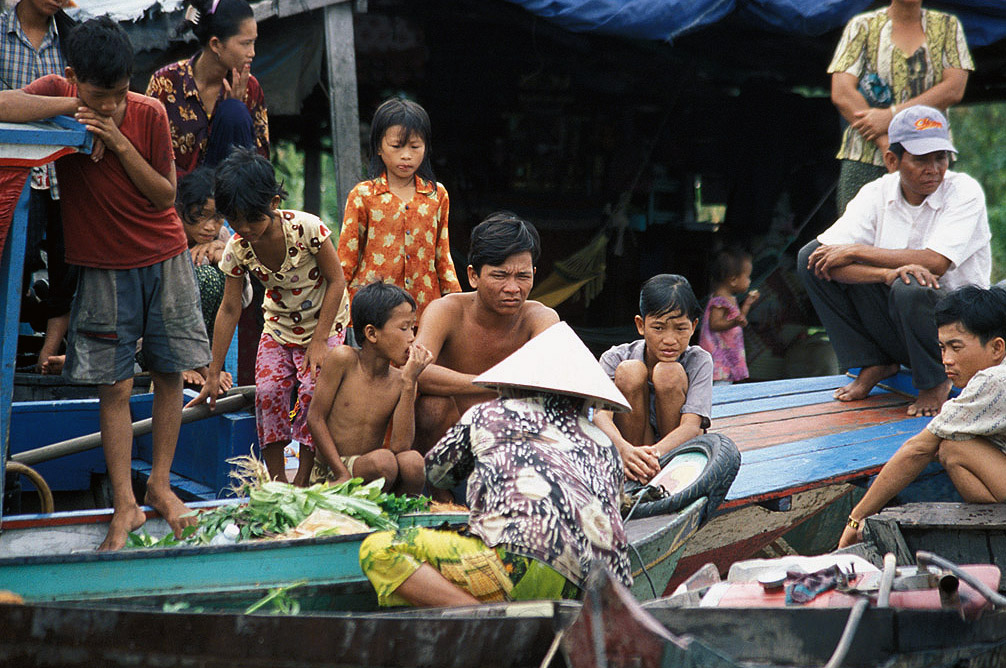CAMBODIA
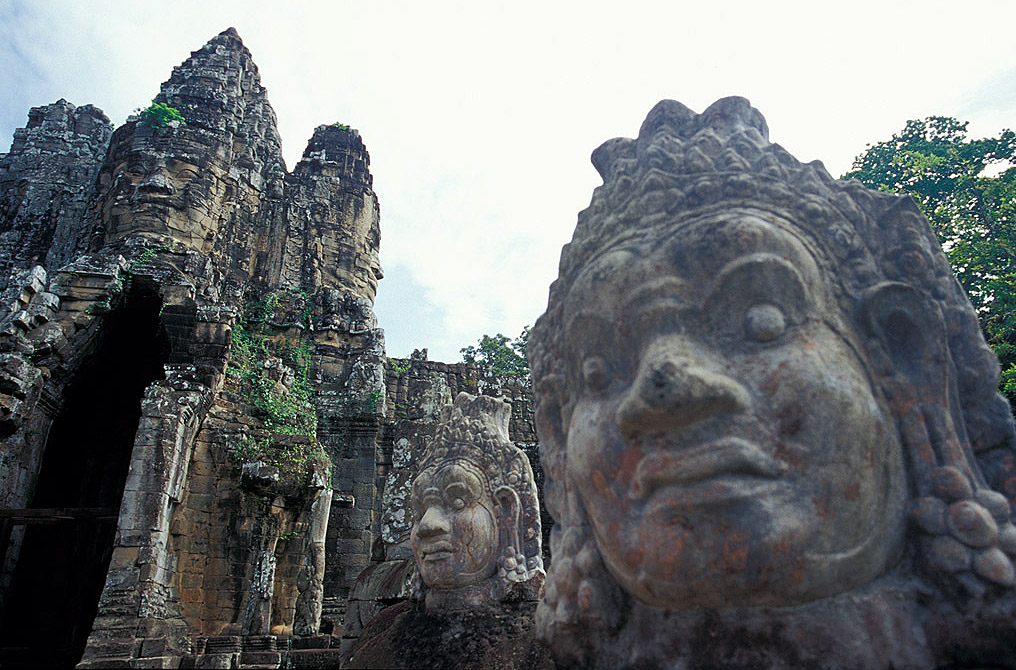
The ancient city Angkor in Cambodia has been attracting a lot of tourists from all over the world with its myriad mysterious and fascinating temple ruins discovery. Angkor is situated about 200 miles away from Phnom Penh, the capital of Cambodia. This city is surrounded by the jungle and is filled with at least a thousand temples and temple ruins. One of the greatest, majestic and most amazing temple structures here is the Angkor Wat. This temple is remarkable even today, after thousands of years.
Angkor Wat features Lord Vishnu as its deity and is a Hindu temple. This temple is spread over a large area and is encompassed by a moat. Every surface at the Angkor Wat temple has elaborate carvings depicting interesting scenes from Khmer life, ancient battles and mythology. The temple has five rounded towers which add to its grand profile. This temple was constructed by at least fifty thousand workers over a period of 37 years and is the largest religious building in the world. In fact, Angkor Wat is known as the mother of all temples.
There are many other temples at Angkor that must not be missed by visitors including the Angkor Thom and the Bayon. Bayon is the centre of Angkor Thom from where you can find 216 huge heads looking down from all around. Angkor Thom was the capital of Angkor’s greatest King Jayavarman VII. The best time to see the effect produced by the faces looking down at you is just before sunset.
Preah Khan is a temple with myriad carvings over unending complex of corridors. The numerous corridors in this two-storied building were constructed to provide heat from the sun. Entrance to this wonderful temple is from the East and midday is the best time to visit this architectural marvel.
Ta Prohm is a unique temple that is being strangled by the roots of the tree around it. Efforts to preserve this temple have been in vain and it stands as it was discovered in the year 1860. Another interesting temple situated about 32 km from Angkor is the Banteay Srei. This temple which means fortress of women is pink in colour and features some of the most fascinating and intricate carvings in Cambodia. Baksei Chamkrong is a step pyramid twelve meter tall. This temple was constructed by Harshavarman I in the early 10th century. A golden Shiva image was installed here in 947 AD by Rajendravarman II who improved and restored the temple.
Phimeanakas is an impressive pyramid temple made of sandstone and laterite. Not many carvings have survived here but this is the tallest temple in Angkor Thom. Visitors scale this tall temple to reach the top and enjoy an impressive view. Phimeanakas was the temple of the Kings and is located inside the compound of the Royal Palace. There are many other temples and temple ruins in and around Angkor with a mysterious and fascinating history. All these temples feature intricate and beautiful carvings and are architectural marvels.
© 2009 Abiyoyo SL
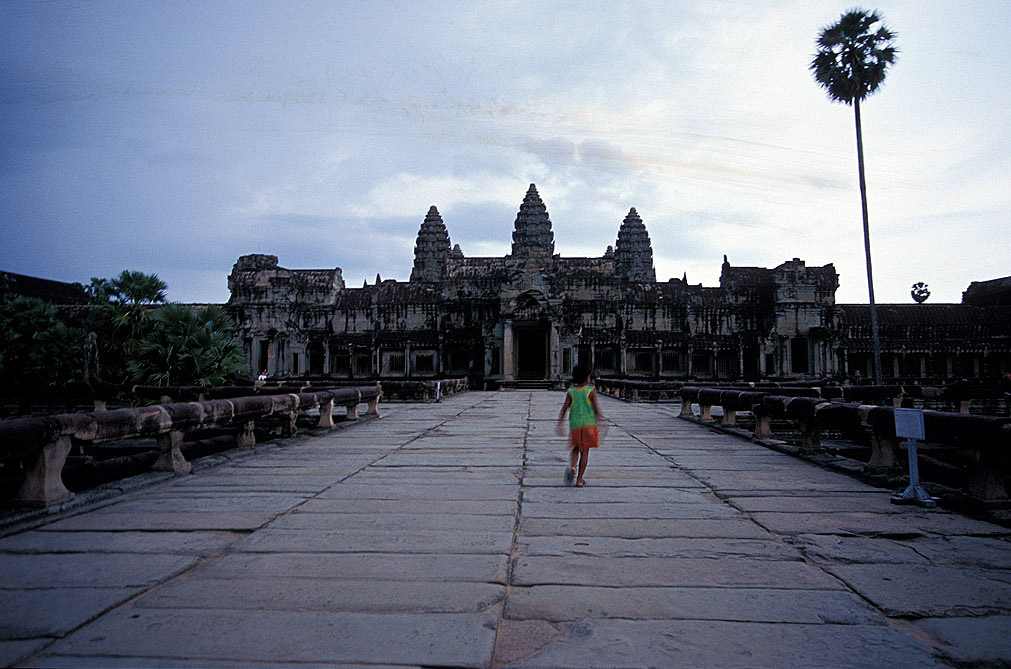
(2 albums)
Angkor Wat is one of the most fascinating, beautiful and majestic temples of Cambodia. This temple is situated at the centre surrounded by at least 40 palaces and temple ruins spread over 200 km. Built in the early 12th century by Suryavarman II, Angkor Wat symbolically represents the Hindu Cosmology and has Vishnu, the Hindu God as the main deity.
This huge temple symbolizes the mystic mount Meru. The cosmic ocean and the chains of the mountains are represented by the moats and rectangular walls numbering five that are inter-nested. Observers are given three day spring equinox anticipation by the skilful construction with deliberately diverted east-west axis and the perfectly aligned north-south axis of the temple.
The bas relief sculpture features some of the most intricate carvings telling us ancient stories of the Khmer civilization. Towering over the jungle, Angkor Wat temple was declared a heritage site by UNESCO in the year 1992 and has been preserved with care since then. This man made wonder is one of the greatest in South East Asia and visitors throng to this fascinating temple through the year. Siem Reap is the base town close to Angkor which provides tourists good infrastructure to stay and enjoy the temples and temple ruins in Angkor.
Angkor Wat architecture is unique with its attention to detail, symmetry and scale and has often been compared to the Taj Mahal and Egyptian Pyramids. This interesting Hindu temple is considered to be a skilful replica of the universe. Surrounded by a moat and accessible through a long causeway, you can find intricate bas relief carvings of God’s deeds and asparas, the female divinities.
Episodes from the Hindu epics Mahabharata and Ramayana are carved on the outer gallery’s inner walls. The Battle of Kurukshetra from the Mahabharata and scenes from the Battle of Lanka where Rama defeated Ravana are depicted on the Western gallery anti-clockwise from the north-west corner. The southern gallery features a historical scene of King Suryavarman II’s procession along with Hindu mythology’s 37 heavens and 32 hells.
Intricate carvings depicting 88 devas and 92 asuras churning the sea of milk with serpent Vasuki can be found on the eastern gallery of the temple. Scenes of Krishna’s victory over Bana and a battle between the asuras and Hindu gods can be found on the northern gallery.
The structure of Angkor Wat, though based on the Indian model of that period sports a unique Khmer architectural style. The specialty of Khmer construction was moving huge and heavy smoothly polished stones to the temple site and assembling them without any mortar. This combined with the fantastic decorations and intricate carvings stands today as Angkor Wat, one of the largest temples of the world.
Today, Angkor Wat is one of the famous and popular tourist destinations in the world. The temple is protected from damage due to the large tourist influx. Floors and bas relieves are protected with the help of wooden steps and ropes. Protection and restoration work at this temple is carried out both by foreign government sponsored groups and the Cambodian government.
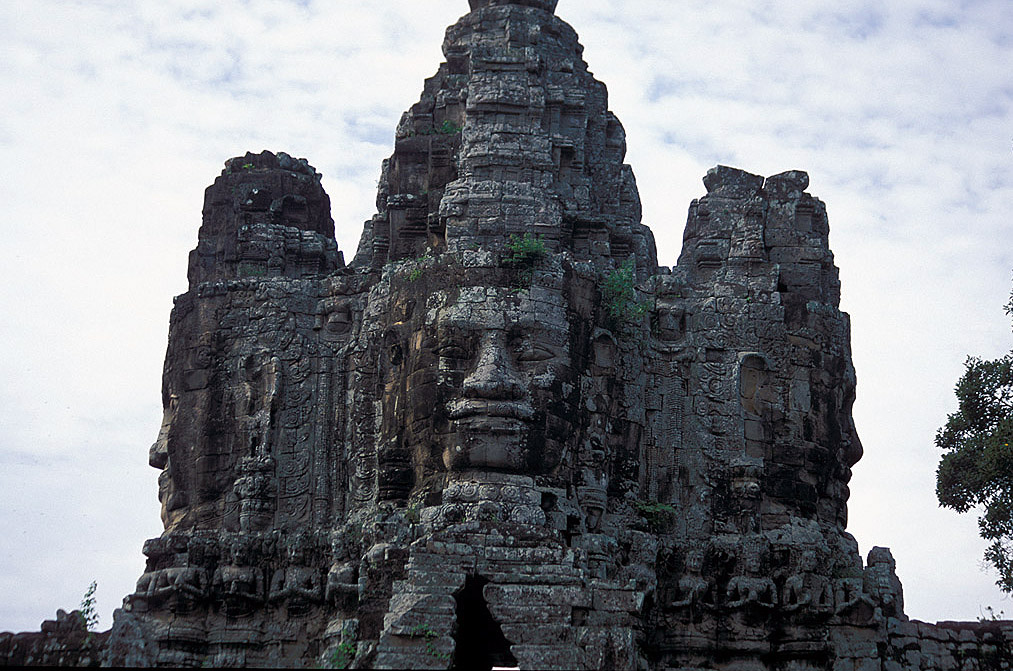
(3 albums)
Angkor Thom is a charming 12th Century Buddhist city which has been attracting a lot of tourists from around the world. One of the most famous temples of Cambodia the Bayon Temple is located here. Angkor Thom was built by Jayavarman VII, one of the great kings of Angkor. This city is shaped as a perfect square with its four sides facing the four directions east, west, north and south. Jayagiri is the wall that interestingly surrounds this city on all sides. This wall is 12 km long and 8 metre high.
A 100 metre wide moat surrounds the walls on all sides for additional protection. At the centre of the walls, a gate opens to the bridge extending over the moat to the city of Angkor Wat.
There are numerous ruins of stone temples in Angkor Thom which are explored with a passion by adventure lovers. One majestic temple ruin features five gates decorated with elephant trunks. Four faces of Avalokiteshwara, which was the king’s favourite motif looks down at you. 54 demons and 54 Gods line the left and right side of the gates.
The Elephant Terrace at Angkor Thom was used by the royalties as a viewing platform. This area is mystical and filled with fascinating picturesque illustrations of garudas and elephants. One of the most famous temples of Angkor the Bayon Temple is located at the centre of the city of Angkor Thom. This Buddhist temple illustrates the intersection between the heaven and earth showcasing some interesting Hindu artistry elements.
This temple features a smiling image that is thought to be that of Jayavarman VII and Bodhisatva Avalokiteshwara’s gigantic stone faces. Stalwart Baphuon is another temple situated to the north of Bayon. This is another temple with unique architecture constructed in the year 1066.
Dom was the predominant architectural style as can be seen in the construction of temples. Laterite has been used on a large scale, especially in the giant monsters close to the towers which carry the naga and each of the entrance’s back towers.
Mangalartha was the last temple to be constructed at Angkor Thom. This temple was completed in the year 1295. While the older temple structures here lasted and were modified periodically, newer structures could not really withstand the test of time due to the perishable materials used.
Each of these temple ruins point out to the unique architectural marvel and intricate carvings that must have been painstakingly etched by skilled artisans of the bygone era. Prominent temples at Angkor Thom are preserved through the efforts of various organizations from around the world as well as by the Cambodian government.
If you are a tourist looking to enjoy going back in time amidst the Angkor Thom temple ruins, you can do so by reaching the Angkor International Airport which is closest to this city. Siem Reap is the base which offers tourists a good infrastructure. You can stay at one of the good luxury hotels which offer an elegant and stylish accommodation.
(BAYON)

(1 albums)
Bayon is the most stunning temple in the city of Angkor, Cambodia. It was built during the reign of Jayavarman VII at the end of 12th century. It was devoted to Lord Buddha, but it includes some elements of Hindu cosmology too. It was the only state temple in Angkor dedicated to the Buddha. It was the masterpiece of King Jayavarman, which served as an inspiration for several other temples in this area.
What to see:
Bayon is located at the exact centre of the ancient city of Angkor Thom and it is renowned for its massive statues. You can see 216 huge stone faces of the Bodhisattva Avalokitesvare or Lokesvar on the towers of the temples. Some scholars believe that these statues are representations of Jayavarman himself.
Bayon temple is encircled by two walls, which feature an awesome collection of bas relieves. These bas relieves depict the legendary and historical events. You can find more than 11,000 carved figurines in the wall.
You can enter the Bayon temple through the east gate and enjoy viewing the carvings. The carved image of Linga (symbol of Lord Shiva) and worshippers bowing before the linga is an excellent piece of art. Some scenes of a naval battle were represented in another carved image. Jayavarman’s victory over the Champs and ordinary life images like a cockfight, a woman seeing fish etc were depicted in the carved images.
The scenes depicted in the inner gallery of the Bayon temple are totally different from that of the outer walls. The canvases in the inner gallery include scenes from Hindu mythology. You can see the figures of Lord Shiva, Vishnu, Brahma, Ravana, Garuda and Apsaras (celestial dancers). Another scene shows a king fighting with a serpent with bare hands. The depictions in the north of the Western Gopura feature asuras and devas churning the sea of milk. The central sanctuary boasts of the primary deity Buddha. The statue of Buddha sitting in meditation and the serpent King Mucalinda shielding him is an inspiring one.
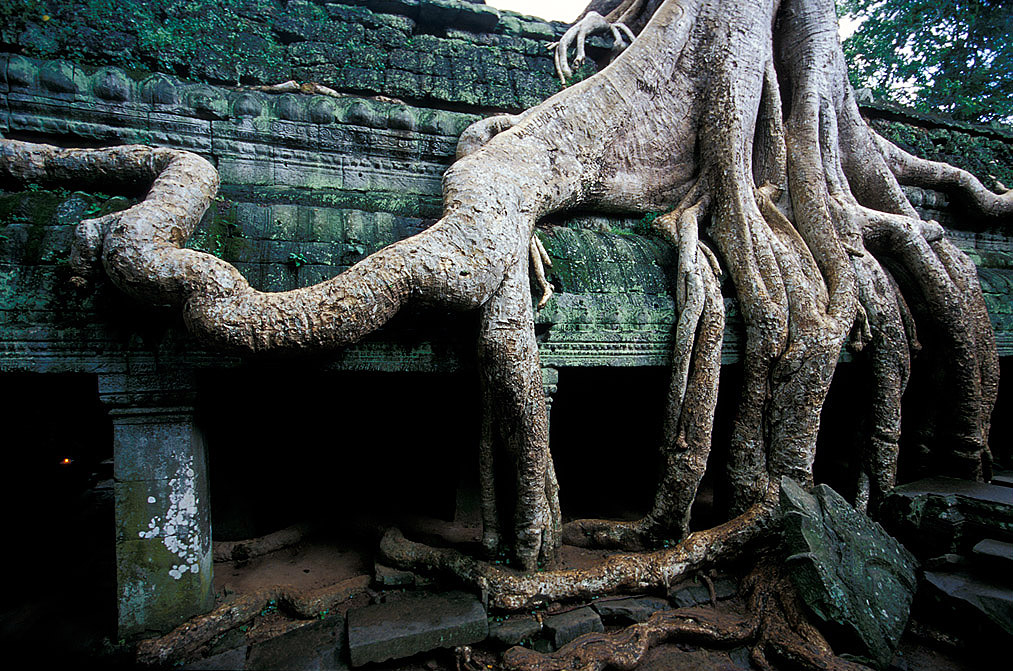
(2 albums)
Ta Prohm is one of the most splendid temples in Angkor, built by Jayavarman VII, a Buddhist emperor. It was dedicated by the King to his mother in the form of a deity Prajnaparamita, which signifies wisdom. One of the rare inscriptions in this temple offers details about the temple’s workers. After the decline of Khmer empire, this temple was neglected for centuries. In the early 20th century, efforts to restore the heritage of Angkor paved way to the emergence of the glory of this beautiful temple. Now it stands as an exquisite example of Khmer architecture.
Attractions:
Ta Prohm is a fabulous site surrounded by great trees. The leaves of these trees filter the sunlight and give cool shade over this ethereal site. The sunrays passing through the leaves spread a fantastic greenish light. Exploring this monument can help us understand the power of Mother Nature. Some trees and vines hew the massive stones at Ta Prohm and fall over the top of the temple. We can enjoy the strangling root formation on the east Gopura, located near the entrance pavilion.
Ta Prohm is partially un-restored, but we can still enjoy viewing the narrow corridors, courtyards and towers. We can try and discover the hidden gems of stone cracks found beneath the intruding plants. It was once an enormously wealthy temple, boasting of great stores of jewels and gold. Though it is now in a ruined state, it is the most wonderful example of the monastic complex style temples.
Ta Prohm has 39 towers that are connected by several galleries. However, we are not permitted to climb onto the galleries, as this may cause damage to us and the temple. The entrance gates feature the face of King Jayavarman. The doors have nice details and the walls have fascinating decorations. The figurines of dancers in the wall are so beautiful that we cannot take our eyes off them.
In addition to enjoying the man made architectural beauty, we can celebrate the serenity of nature here. The twisted roots of wide trees snake through the ruins of Ta Prohm. If time permits, we can explore several small, yet striking statues protected by tree roots. We can see several more fantastic trees in temple shots, if we use the western gate to enter into the inner sanctuary. There are many inspiring trees and sculptures in the northern side of the inner sanctuary.
Ta Prohm has become a famous tourist site since 2001, as the film Tomb Raider used it as an important location. The weird qualities of the temple were depicted obviously in certain scenes and the film portrayed the temple as close to the actual appearance as possible. The elongated white sandy path between the entrance gate and the inner sanctuary of the temple is courtesy of the film.
The best time to plan a visit to Ta Prohm is in the afternoon, as the light falls best in the southwest courtyard, allowing us to explore the marvellous sculptures and trees.

(1 album)
Banteay Kdei is one of the famous temples in Angkor, Cambodia. It was built by King Jayavarman VII in the late 12th century to early 13th century. It is much similar in plan to Ta Prohm and Preah Khan, but it is smaller than those temples. It followed the monastic pattern of Ta Prohm. It was built in the Bayon style. This Buddhist temple was occupied by monks at various intervals. As no inscription stone has been discovered, it is not clear to whom the temple is dedicated. It is in a ruined state, due to the faulty construction and poor quality sandstone. Restoration work is under way at this site.
Attractions:
Banteay Kdei was built as a Buddhist monastic complex. It is located on the shore of Srah Srang. You can begin your visit at the east Gopura near Srah Srang. The temple has two consecutive enclosure walls, which comprise of two concentric galleries. Though no information available about the deity this temple is dedicated to. A tenth century inscription found in the western gopura specifies that the second enclosure was sculpted on re-used stones, from the neighbouring temple of Kutisvara.
The east gopura entrance has smiling Lokeswara features, which are similar to those at Ta Prohm. The doorway is guarded by garudas in each corner. The large Buddhist terrace located in front of the temple is decorated with naga and garudas figurines. You can also see lion statues that were sculpted in the Bayon style. The terrace with naga and garudas balusters is slightly raised.
Banteay Kdei has a large rectangular shape hall, which might have served as a space for dance programs. This rectangular hall is almost similar to that of Ta Prohm and Preah Khan. The entrance has square columns and is adorned with apsaras. Both paired and single dancing apsaras were sculpted in low relief. The hairstyle and jewelry of apsaras can be clearly seen in these sculptures. The lotus buds at the bottom of the dancing apsaras figurines were carved elegantly.
The third enclosure gopura has internal columns and the walls of porches featured Buddha images. These images were destroyed during the period following Jayavarman’s reign. The third enclosure is covered by vaults that are constructed with sandstone and laterite. They collapsed due to the ravages of time. You can access the eastern entrance of Ta Prohm temple from the rear of this complex.
Banteay Kdei temple stands as an evidence of two different art styles – Bayon and Angkor. Many tourists miss this spot and they often only visit Ta Prohm and Preah Khan. However, Banteay Kdei is a worthy place to visit. It is not only spacious, but also has tree-shaded beautiful grounds. It does not have much traffic, so it is a great place, if you want to spend time leisurely. Though it lacks the symmetry of other popular temples in Angkor, you can enjoy viewing some marvellous sculptures. The rectangular courtyard also known as the hall of dancing girls is surely a lovely spot to visit.
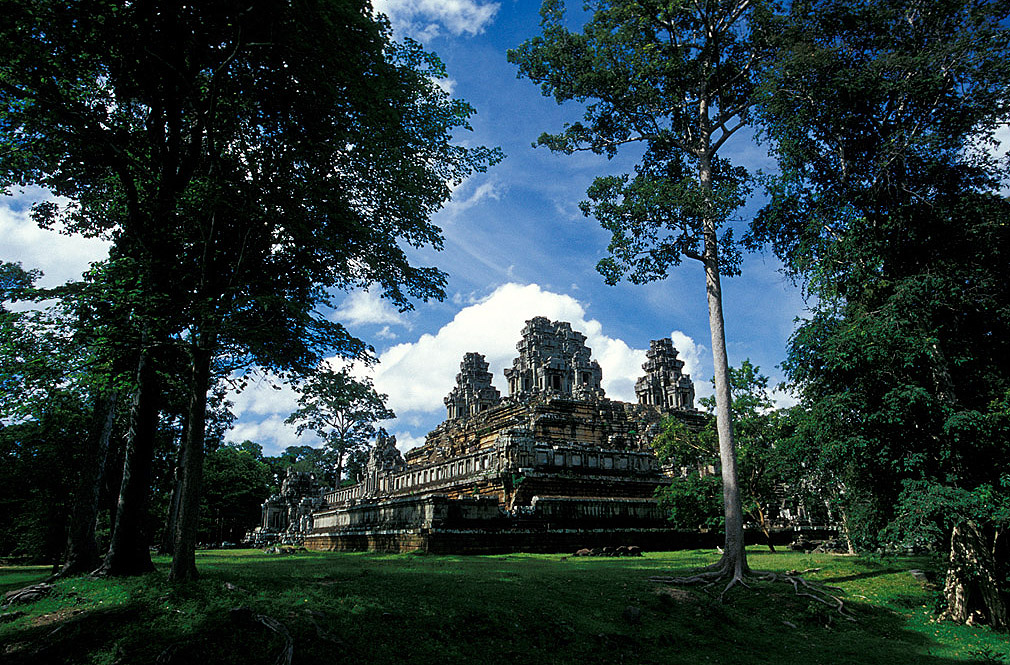
(1 album)
Ta Keo is a famous Hindu temple in Angkor, Cambodia, which is dedicated to Shiva. It takes the form of renowned Temple mountain style and it may be the first temple to be constructed entirely with sandstones in the history of Khmer. It was built by Jayavarman in 1000 AD. It was once referred to as “Hemagiri “, which means the mountain of golden peaks. This temple was abandoned uncompleted, as a thunderbolt hit it and that event was considered as a warning sign of evil things. This temple worked as a cult centre till the end of 13th century.
Things to see:
Ta Keo was built in a temple mountain form, which is a symbolic representation of Mt. Meru, with five towers. The towers are arranged in a quincunx pattern (a geometric pattern to denote a shape having five points). The uppermost level of this pyramid consists of partly covered terraces. It is surrounded by a moat, which helps to indicate the oceans surrounding Mount Meru. Lack of exterior embellishments and carvings does not affect the massive appearance of this temple.
The causeway that leads to the eastern entrance of Ta Keo is 500 meters long. The wall of the first terrace was made up of sandstone on laterite basis. There are two galleries and their roofs were believed to be made up of wood and tiles. The balustrade windows illuminate the galleries.
The second terrace has a gopura that has three independent passages. The inner enclosure of the second terrace has windows only toward interior. It has no doors at all and it is the finest example of Khmer gallery. There are two buildings situated next to the eastern side of the second terrace. You can also see two little libraries made up of sandstone, which are open to the west. They have false windows too. The inscriptions on the door jambs of the eastern gopuras make reference to the donations made to the temple.
The temple was constructed carefully and the systematic cutting and placing of huge blocks of stones stand as an evidence for it. Despite the absence of moulding and ornamentation, it remains perfect. The frontons that were reconstructed on the ground depict the sheer style of ornamental decoration. The upper platform is in square plan and has the towers in unfinished form. They open to the four cardinal points. The corner towers are dominated by the central tower, which was constructed wonderfully. It is raised above the other towers and comprises of porches and pediments. The interior of the central tower is not decorated. You can see the fragments of lingas and pedestals in and around the towers.
Ta Keo would have one of the exquisite temples at Angkor, if it had been completed. Anyhow, it is worth to visit it. In fact, its simplicity makes it different from other monuments in Angkor. The architectural style of this temple is a great example for the growth of good taste among people lived in that period. As you need to climb on the steps to enter the temple, it is advisable to plan a visit in the morning.

(1 album)
Preah KO is one of the most impressive temples, located fifteen kilometres away from the main group of temples in Angkor, Cambodia. It was built by Indravarman I in 879AD to honour his ancestors. The main deity of this temple is Lord Shiva. In fact, the name Preah Ko refers to the sacred bull, the vehicle of Lord Shiva. Originally, the dedication of this temple was made to Indra, the king of devas. Preah Ko is renowned for the intricacy of its carvings. It has many bull statues in the front of the temple’s central towers.
Towers:
Preah Ko comprises of six towers made up of brick, which are arranged in two rows. All of them face east and the central tower is the largest. This central tower is dedicated to Jayavarman I, who was the founder of Khmer empire. The left side tower is dedicated to Indravarman’s father, Prithivindreshvara and the right side tower is devoted to his grandfather, Rudreshvara. The rear towers are devoted their wives. The tall central tower includes the images of Lord Shiva. The towers were once surrounded by walls and gopuras, but now there are neither walls nor gopuras. Actually, Preah Ko was encircled by a moat, when it was built. There must be royal palaces once in the nearby areas, but now there is no sign of remains.
Statues:
In front of the prasats of Preah Ko, you can find majestic lions, guarding the place. Though the face of the lion figurines are in ruined state, you can see the powerfulness of the lion in the claws and in the posture. The bull sculptures in front of the base platform stand as an exquisite example of Khmer architecture. The ornamental bells in the bull’s neck can be clearly seen.
The carvings in the lintels show three headed nagas, deity mounted on a kala and horsemen. As per Hindu mythology, the nagas have multiple heads to signify fertility and water. The intricate designs in the carvings are so beautiful that you may not be able to take your eyes off. Kala is the god of destruction and he is depicted as a giant in the carvings.
Preah Ko has three false doors on north, west and south side. In Hindu temples, the shrine is opened only to the east and so the false doors were simply constructed to maintain symmetry. You can see decorative carvings in the false doors in Preah Ko. The steps leading to the prasat and the false doors have carvings of human faces, with various hairstyles and jewellery.
Preah Ko is believed to be the first temple built by King Indravarman. It is located among the Roluos group of temples, so you can plan to visit other major attractions like Lolei, Bakong etc. You can enjoy viewing the octagonal colonnettes that surround the doors in Preah Ko. A famous archaeologist Jean Laur specified that these colonnettes are the most excellent examples of decorative carving in Khmer art. As it located some kilometres away from Angkor, it is better to get a tuk tuk driver, who is more familiar with the way to the temple.
Bakheng is a Hindu temple constructed in the style of Temple Mountain in Angkor, Cambodia. It was built during the reign of Yasovarman in between the period of 889 and 910 AD. This temple is devoted to Lord Shiva and is a symbolic representation of Mount Meru, a scared mountain in Hindu mythology. It is one of the three temples located atop a hill in Angkor region. Today it has become famous, as the sunset views of the famous temple Angkor Wat can be enjoyed well from here. It is worthy to reach the hill before sunset to enjoy the panoramic views of Angkor and its surroundings.
Attractions:
Bakheng was constructed carefully to maintain symmetry and every structure in this temple presents a piece of the cosmic order. The seven levels of this temple represent the seven important Hindu mountains. There are 44 towers around its base and four sandstone towers on the summit. These four towers are positioned in prominent cardinal points to guard the central sanctuary. The total number of towers is 108, which is regarded as an auspicious number in Hindu mythology. The number also has cosmological importance. The towers are distributed over four levels and are placed symmetrically. You can see only 33 towers from the centre of any side. 33 is the number of gods residing in Mount Meru.
A moat surrounds the mount and the temple and parts of this moat can be seen from the air. There is another small moat inside. A causeway from the old capital area to the east section of the outer moat connects to the east entrance of the temple.
As the path to the summit is too steep, an alternate pathway has been opened. You can go for an elephant ride to get to the top of the hill. It is in fact a funny way to reach the summit. Bakheng is crowded in the evenings, but it is really worth to plan a visit in the late afternoon. If you want to avoid crowd, you can visit in the early morning to enjoy the awe-inspiring sunrise views.
Bakheng is one of the most wonderful examples of the Temple Mountain style of architecture. The stepped terrace cut into the side of this complex creates a pyramidal incline. This temple is noted for its delicate sculptures. You can see many deeply carved figures in this temple.
How to go:
Bakheng is situated around 1km away from the north of Angkor Wat. If you want to enjoy a different experience, you can plan to reach the temple by climbing the steep path having some steps on the east side. Once you have reached the top of the hill, you can see five towers of Angkot wat in the west, Phnom (hill) Bok in the north east, Kulen hill in the east and the West Baray.
Bakheng use to be one of the most serene place in Angkor because you could feel its potent charm during sunrise and sunset. Unfortunately is getting more and more crowded these days. If time permits, you can spend a few more hours in the hill to enjoy the stars peering through the strands of floating cloud.

(1 album)
Neak Pean is one of the renowned Buddhist temples in Angkor, Cambodia. It is located on an artificial island. It was built by Jayavarman VII at the end of 12th century. The term “Neak Pean” means “the entwined serpents”. As the sculptures of snakes run around the base of the temple structure, it derived that name. This temple was originally designed as a hospital and then it was transformed to a Buddhist temple. It is different from other temples in Angkor, as it was located on an island in the middle of the man-made reservoir.
Specialities:
Neak Pean has four connected pools, which are the symbolic representation of four important elements water, Earth, wind and fire. It is beautiful in wet seasons, when the ponds are filled with water. The scholars believe that Neak Pean is a representation of Anavatapra, a lake in Himalayas, whose waters have magical powers to cure diseases. As the pools stand for four elements, it is believed that they would balance the elements in the bather and cure the diseases. The central water source can be found in the middle of these four ponds.
The statues of two nagas that surround the base of this temple were sculptured marvellously. These two nagas symbolize the naga kings Nanda and Upananda. The heads of these nagas tangled on the east side of this monument and their tails entwined on the west side.
The island on each side of the temple was defined by laterite steps with pavements set on the axes. The four corners of the temple must have small elephant figurines, but now there is only one in the north east side. The upper platform of Neak Pean resembles a huge lotus flower and motifs at the base of the prasat were carved wonderfully in a row of sixteen opposing petals.
Neak Pean’s central sanctuary has two upper tiers that are crowned with lotus flowers. The frontons are dedicated to offer details about the life of Lord Buddha. You can see the event “ cutting of the hair” in the east, Buddha meditating under the Bodhi tree in the west and the Grand Departure in the north. The tympanum in south side was destroyed. The false doors in north, west and south sides boast of fine panels that contain beautiful images of Lokeswara, the bodhisattva.
Neak Pean was restored by the process of anastylosis. It is quite different to see Neak Pean in the renovated form. You can see a statue of Bahala, a Bodhisattva Guan Yin who transformed into a horse in this temple. This statue is a symbol of drowning prevention.
How to go:
Neak Pean is located 2.5 kilometres away from Preah Khan. If you want to see the waterspouts in the form of animal and human heads, you can plan your visit to this temple in summer, when the pools are empty of water. However, a delightful setting is created in the months of October and November only. The ponds rely on the flow from the neighbouring river and you can enjoy the manmade decorative carvings and the beauty of nature there.
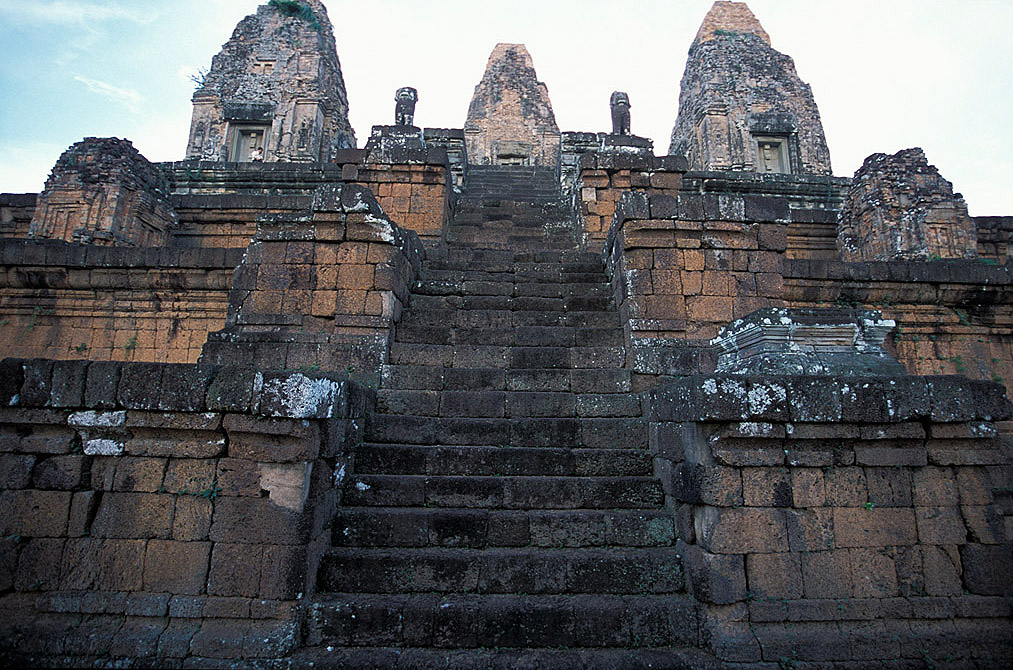
(1 album)
Pre Rup is one of the most fabulous Hindu temples in Angkor, Cambodia. It was constructed during the reign of King Rajendravarman in 961 or 962 AD. It is dedicated to Lord Shiva and the name of the linga (a form of Shiva) is Rajendrabhadreshvara. It was built in the temple mountain pattern, which is an architectural representation of Mount Meru, the home of gods. It was made up of brick, sandstone and laterite. The name Pre rup carries the meaning “turn the body”. According to ancient Cambodian belief, the funerals conducted at the temples would make the ashes ritually rotated in different directions.
Attractions:
Pre rup was constructed using laterite and brick, which give a pleasant reddish appearance to it. It looks awesome in early morning and late afternoon sunlight. It has a square lay out and a laterite wall surrounds the temple on all four sides. It features a massive gopura that has three doorways. The main entrance is at the east gopura, where you can see a row of six towers. The first tier in the east gopura can be reached by a steep staircase. You can find libraries on either side of the walkway on the second platform. There is a stone reservoir, which must once have been a basement for a nandi statue. Nandi is the vehicle of Shiva and it is a common practice in Hindu temples to keep nandi statue in front of Shiva.
From the top tier, you can view the surrounding areas well. The Kulen hills in the east and Angkor Wat in the west can be seen from this top tier. You can also enjoy viewing the amazingly carved false doors on the upper level of this temple. The carvings are richly detailed and well preserved. The architectural style of this temple is almost similar to that of East Mebon.
The three narrow tiers serve as a pedestal for the five towers on the top platform; of the five towers, four are located in four corners and one is located in the center. The outer enclosure wall has two groups of three towers and the towers of each group share a common base. You can see the complete lintel on the tower at the far left on the east face. You can see a figurine showing the Narasimha avatar of Lord Vishnu, a man-lion. The sandstone pillars in the east, windows with balusters in the west are so beautiful to view. The east entry tower has high towers that shelter carved stones, which represent the motifs of nine planets. The seven ascetics can also be seen in the libraries.
The tower in southwest corner boasts of a depiction of Goddess Saraswati, wife of Brahma. On the western side, you can see the wild boar avatar of Lord Vishnu. The figurines of flying apsaras can also be found here. The west towers have feminine figures, while the east and central towers have masculine figures. Deities carved as bas relieves guard the eastern door of the central tower.
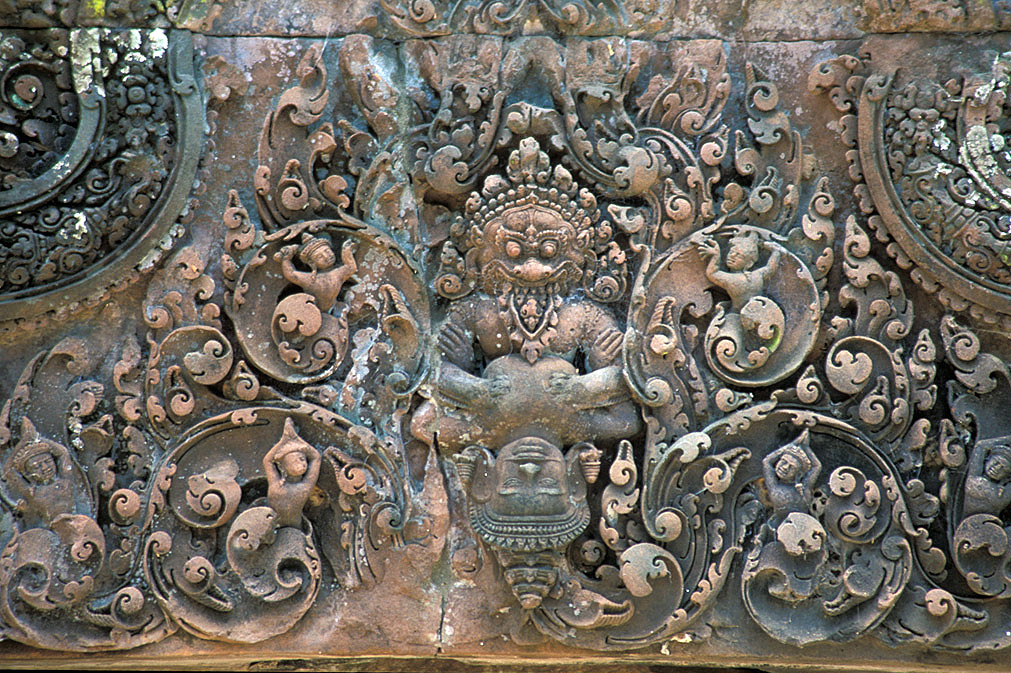
(1 album)
Banteay Srei is a magnificent Hindu temple in Angkor, Cambodia. It is located near the hill Phnom Dei. It was constructed in 967 AD by Yajnavaraha, a counsellor to King Rajendravarman. This temple is dedicated to the Hindu God Shiva. It was originally known as Tribhuvanamahesvara. Now it is referred by the modern name Banteay Srei, which means “citadel of beauty”. The intricacy of the carvings and small dimensions of architecture justifies this name.
The temple was divided along the central east west axis later and the north of the axis was dedicated to Lord Vishnu. The temple was further expanded in 11th century. It was rediscovered in 1914 only and then it was restored by anastylosis.
What to see?
Banteay Srei was built largely by using red sandstones and bricks. Laterite was used only for the enclosure walls. Red sandstones can be carved like wood and you can view numerous beautiful figurines in this temple. It is renowned for the beauty of the lintels and pediments made of sandstone. Lintel is actually a horizontal beam that connects two vertical columns between a passage way. Pediment is a triangular structure above the lintel. You can see the pediments that tell us some interesting stories related to Hinduism.
The sculpture in which Ravana( a demon) shaking Mount Kailasa where Lord Shiva is enthroned helps you understand the story. Similarly, another pediment depicts Kama (God of love) arriving to disturb the meditation of Shiva. You can also see pediments portraying Vishnu themes like “Krishna killing Kamsa and the” rain of Indra” The lintels have kalas on looped garlands. You can see dvarapalas, the guardians and the colonnettes in this temple.
Banteay Srei comprises of three rectangular enclosures that were built on an east west axis and a causeway that is situated on the axis. You can enter the temple via the causeway. The inner enclosure has a sanctuary, three towers and an entrance chamber. It also includes two buildings which were converted into libraries.
The eastern pediment of the Gopuras shows Indra, because he is the God of east direction according to Hindu mythology. You can also see the vehicle of Indra, a three headed elephant Airavata. The beautiful figurine of Lord Shiva Nataraja (the dancing posture of Shiva) can be seen in the eastern pediment of the east gopura.
The east pediment on the north library in this temple depicts a beautiful story. Agni the God of fire sets fire to kill a naga living in the forest. Indra creates rain to stop Agni. Krishna and his cousin Arjun help Agni stop the rain and kill the naga.
The sanctuary in Banteay Srei includes an entrance chamber, which has a corbelled rood made of brick. You can then enter a short corridor directing to three towers on the west. The six stairways that lead to the platform were guarded by two human figures with animal heads. Now you can see only the replicas of those statues. The originals were stolen or transferred to museums.
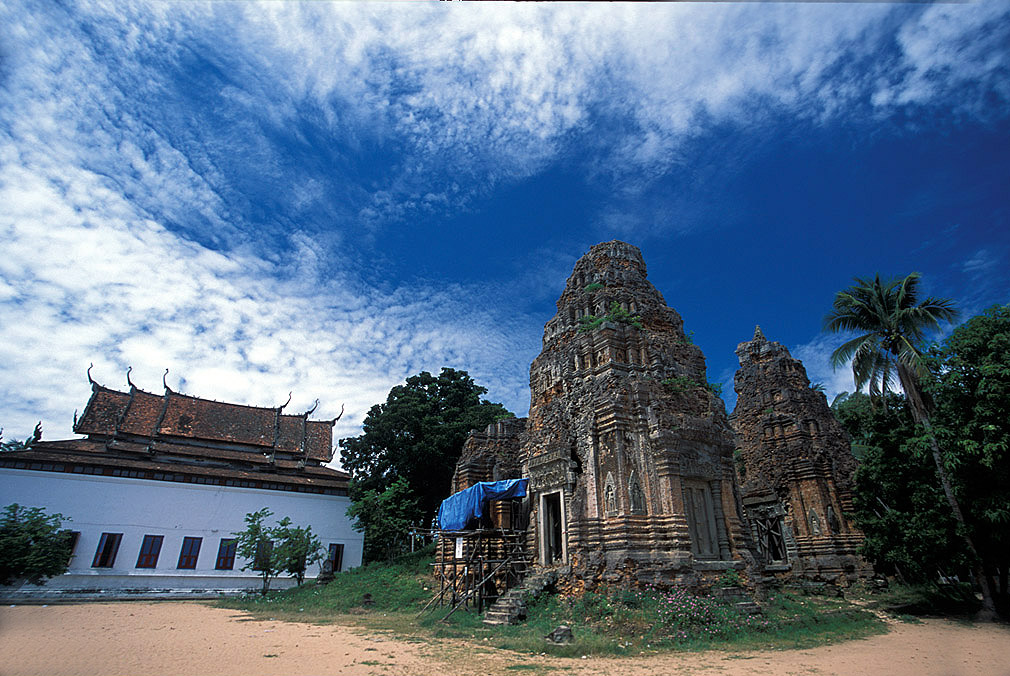
(1 album)
Lolei is one of the impressive Roluos group temples in Angkor, Cambodia. It was the last temple built at Roluos by Yasovarman I and he dedicated it to Lord Shiva. Yasovarman constructed this temple to the memory of his ancestors, especially his father King Indravarman I in 893 AD. Lolei was located on an island originally in the centre of a baray, named the Indratataka, but now the baray is dry. The purpose of building this temple in the middle of a body of water was to symbolically represent the Mount Meru, the home of Gods. According to Hindu mythology, Mount Meru is surrounded by all the oceans in the world.
What to see in Lolei?
You can plan a trip to Lolei to celebrate viewing the marvellous carvings and inscriptions on the lintels. It comprises of four towers that are grouped together on a terrace. The temple towers are noted for their attractive elements. You can see the Khmer inscriptions on all the door jambs. These inscriptions provide plenty of details about the temple. They also give a description about the dedicated tasks carried out by hundreds of servant, who helped in the construction of this temple. The towers of the temple had an outré wall and people accessed to the site through a gopura. Now, the gopura and the wall are not there.
The temple towers are also renowned for their false doors, carved devatas and lintels. The Hindu shrines are opened in one direction, typically to the east and the other three sides have false doors to maintain symmetry. In Lolei, You can enjoy viewing elaborate details on the false doors. The dvarapalakas guard either side of the false as well as real doors.
Lolei is famous for the sandstone carvings too. A sandstone carving in an arched doorway features a fanged dvarapala armed with a trident. You can see two makaras (serpent like monsters) whose heads face outward at the level of his elbows. The most important motif represented in the lintel and sandstone carvings is Indra, the God of devatas and sky. His white elephant Airavata can also be seen in the carvings. The multi headed nagas are exquisitely carved in sandstones. As per Hindu mythology, the nagas have three or five heads to represent water, fertility etc. The heads of the nagas were arranged in a fan like pattern and each head has a flickering hood.
The four sanctuary towers in Lolei temple were made up of brick and were asymmetrically placed. Of the four towers, the two in front are most important. They are in square plan and have a four tier structure. You can find a Buddhist monastery near this temple, which has a monk’s quarters. Even in the 9th century, there was an ashrama in that place.
How to go:
Lolei is located thirteen kilometres away from the east of Siem Reap. Even the ruins and remains of the original ensemble here are worth to see. It is wise to visit Lolei, if you plan a trip to other famous Roluos group temples.
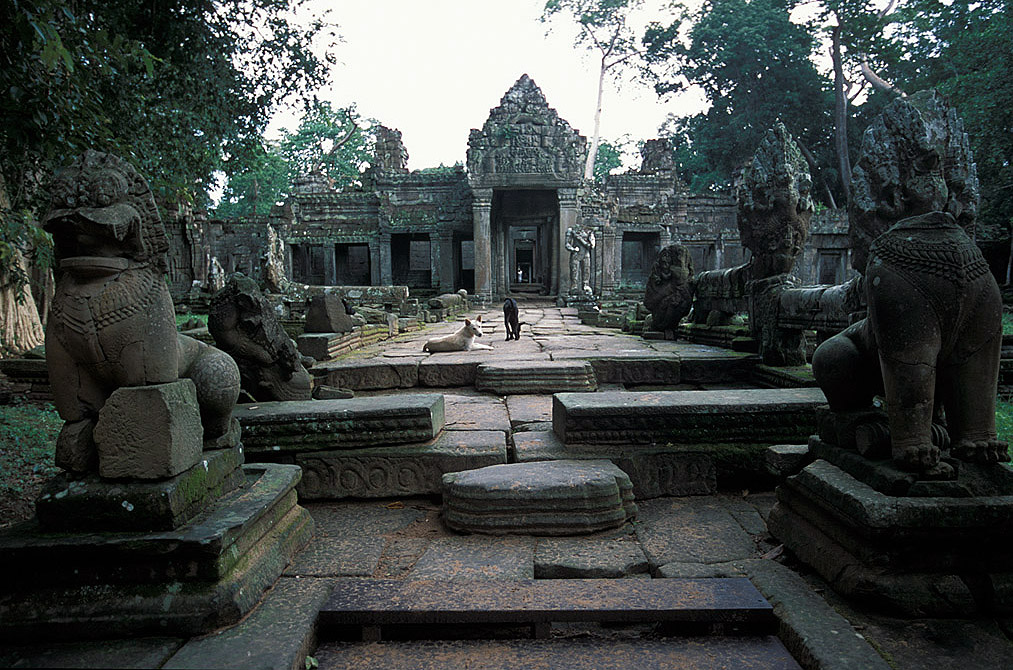
(1 album)
Preah Khan is an eminent temple in Angkor, Cambodia. It was built by King Jayavarman VII in the 12th Century. The main deity of this temple is Avalokiteshvara, which symbolizes compassion. It was originally used as a monastery and University. Though Jayavarman was a Buddhist, he dedicated spots to place the elements of Vaishnava and Shaiva worship. However, most of the Buddhist images were destroyed by a later King. Even now, you can see some of the boundary stones have lotus bud caps on the top.
Preah Khan is located near the famous Ta Prohm temple and both these temples have been left un-restored, with several trees growing among the ruins. Now it is maintained by the World Monuments Fund.
What to see?
Causeway:
The beginning of the entrance causeway in Preah Khan has several boundary stones, boasting of lion headed monsters. You can view Garuda with human torso and legs here. The top segments of the boundary stones held images of Buddha, but were destroyed by a King in the second half of the 13th Century. The causeway becomes broad near the enclosure wall, which is surrounded by a moat. Moat is a deep ditch filled with water to protect the castles or temples from enemies.
The external wall of Preah Khan is of laterite and it has 72 garudas that hold nagas at 50 meter intervals. Garuda is a bird man and he is the vehicle of Lord Vishnu. He is the enemy of the nagas. The statues of Garuda have clawed hands and feet that hold the tail of the naga.
The causeway near the enclosure wall also has stone giants holding nagas. One side of the causeway is decorated with the statues of gods and the other side has asuras. The nagas have either five or seven heads, which are associated with creation, fertility and water. The nagas were sculpted carefully and you can even notice the incision in them that represents the reptilian skin.
Towers:
The Gopura has a central tower, featuring beautiful galleries. The galleries link two nearby towers. The middle tower has five tiers and the two towers on either side have three tires. You can enjoy viewing the fantastic budding lotuses that decorate the top of the towers. The gopuras have balusters and false windows, which stand as an example of the Bayon style.
Other attractions:
You can view the cylindrical columns to the west of the main temple. Preah Khan is the only example of round columns. The temple is actually flat in design and it boasts of rectangular galleries around a Buddhist sanctuary.
In the northern side of the temple, you can see the House of fire or Dharmasala, which is much similar to Ta Prohm’s. The third eastern gopura has a hall of dancers at the west side. The walls are adorned by apsara (beautiful woman) sculptures.
You can view satellite temples, Shiva and Vishnu temples in the Preah Khan temple. Sculpture of Lord Krishna raising mount Govardhana can be seen on the western side. Though Preah Khan has not been restored to a great extent, it is worth planning a visit there to enjoy the fascinating sculptures.

(1 album)
Bakong is located in Rolous, Cambodia. It is the first state temple of sandstone built by Indravarman I in 881 AD. Later, Bakong received some beautiful additions. The uppermost tower may have been built in the 12th century. This temple is dedicated to Lord Shiva as Indreshvara. It served as an official state temple of the king for a few years. Later Indravarman’s son Yasovarman moved his capital to Angkor and constructed a new temple mountain there. However, the glory of Bakong remains unaffected for the past twelve centuries. It is noted for its fantastic architectural style and sculptures.
Architecture:
Bakong was constructed by using the famous temple mountain scheme, which is actually an architectural representation of Mount Meru, the home of Hindu gods. The base of this temple is a five tired pyramid, which represents the five monarchies of snakes, garudas, rakshasas, yakshas (nature spirits) and Kings.
What to see?
The temple boasts of three enclosures, which are separated by two moats. The outer enclosure does not have a gopura or wall and its boundary is simply the moat. In this outer enclosure, wrecks and leftovers of nearly 22 sanctuaries can be found.
The inner moat is made of laterite and it comprises of four gopuras. The seven headed naga can be found on the side of the entrance causeway. The innermost enclosure is surrounded by a laterite wall and it includes the central temple pyramid. You can view eight temple towers made of bricks, four on each side of the central temple. There is also a modern Buddhist temple outside the eastern gopura. The brick towers have their original supporting beams made of wood and they remain unaffected for years.
Though Bakong temple had several beautiful carvings in stucco, now you can see only the fragments. However, you can enjoy viewing an enthralling scene in stucco, in which the asuras fought a battle. This is a marvelous example of the high quality carvings in this temple. You can also view large stone statues of elephants that are sculpted as guardians to guard the corners of the three levels of the pyramid. The majestic statues of lion guard the stairways.
Bakong temple has twelve exquisite stupas, four to a side on the third tier. The fifth tier has a sanctuary, which was a later addition. Though the temple has five tiers, processions and festivals were conducted only in the pyramids. You can enjoy viewing several lingas, statues of Shiva and Vishnu in the pyramid.
The eastern side entrance has a pavement lined with standing bornes and you can see the remains of two symmetrical rooms, featuring large balustered openings. The north east and south east corners of the enclosure include two contrasting square brick buildings. There is an opening in the west, which is sculpted from a monolith of sandstone. They receive sunlight via a pattern of round holes. The towers in this temple are open to the east and have four stairways. They are adorned with fantastic lion statues at their bases.
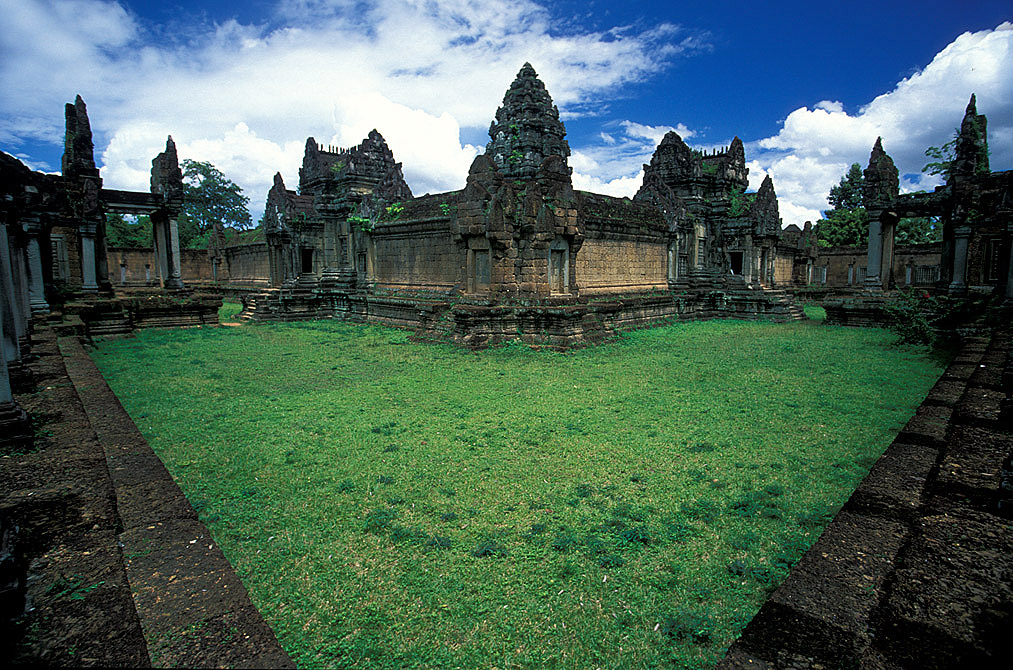
(1 album)
Banteay Samre is a renowned temple in Angkor, Cambodia. It was built during the reign of Suryavarman II and Yasovarman II in the early 12th century. It is a Hindu temple that has bas-reliefs of Lord Vishnu. Bas relief is a form of sculpture in which a piece of material is carved in such a way that the objects project from the background. In Banteay Samre, the bas reliefs are well preserved and one of them is a wonderful relief of Vishnu, which depicts the deity as a lotus navelled creator of the world. It is a temple surrounded by a moat and is less crowded.
Specialties of Banteay Samre:
Banteay Samre is one of the temples restored by using the method of anastylosis. It is named after Samre, an ethnic group of mountain people. They might be related to the Khmers. Though no inscription has been found in the temple, the style of architecture shows that it belongs to the middle period similar to Angkor Wat. The interior moat with laterite paving is the most inspiring feature of Banteay Samre. If the moat is filled with water, it would give an eerie atmosphere to the temple. The buildings around the moat were constructed over a raised base. They are adorned with marvelous figurines framed by lotus buds.
The 200 meter causeway made of laterite in the Banteay Samre temple is bordered by naga balusters. You can see stone lions at regular intervals. The lion paw on this causeway was sculptured so beautifully that you can see the nails clearly. This statue depicts lion as a ferocious creature. The outside enclosure wall was constructed with laterite. It boasts of a tile covered gallery and one of the walls of this gallery joins a gopura, which offers a picturesque appearance. Most of the scenes on the pediments are extracts of the Vessentara Jataka. Though it is a Hindu temple, you can see Buddhist scenes also. Some places have sculpted Buddhist motifs, which help understand that religious tolerance was prevalent at that time.
Banteay Samre has a stone tank that features a hole at the top and drainage channel at the bottom. This tank has been restored by anastylosis and placed in the large room near the central sanctuary. It is regarded as one of the types of coffins.
The external wall with four gopuras encircling a courtyard in this temple is well preserved and beautiful. The steps lead steeply from the outer wall, which help access the central courtyard. The north, south and west gopuras are cruciform in plan and they have two wings that connect the galleries. The porticoes have tympanums that are sculptured fabulously. If you plan on visiting the beautiful Banteay Samre, do not miss the finely preserved panel on the north gopura located in the northern side.
Banteay Samre is a terrific example of Khmer art. It is better to plan a trip to this temple in the morning, so that you can enjoy viewing the sculptures in the corners clearly.
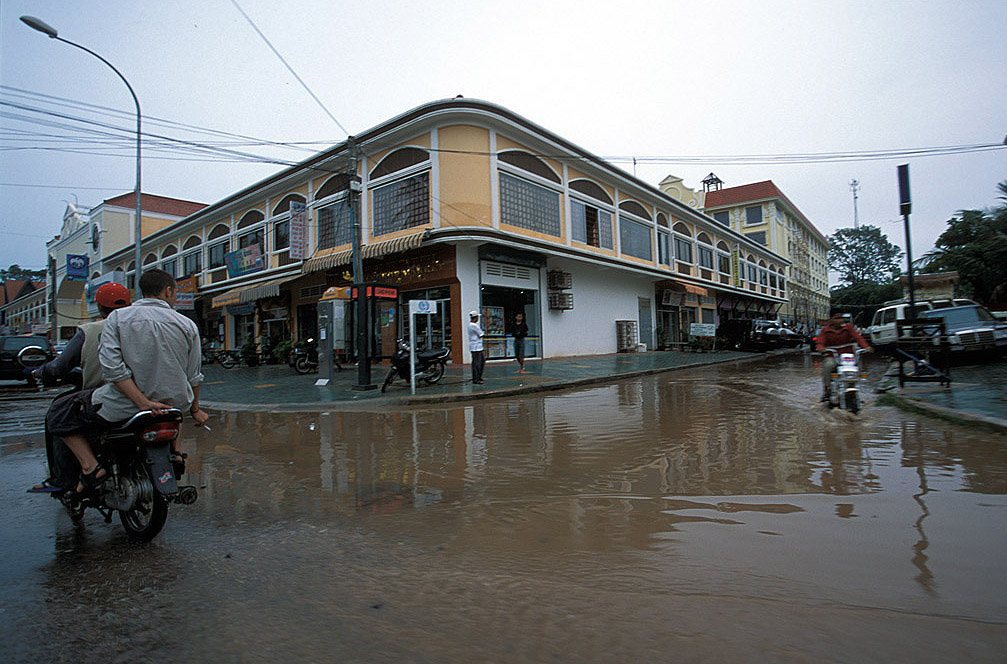
(1 album)
(2 albums)
Siem Reap is a big city located close to Angkor Wat. In fact, this city is the base which provides the necessary infrastructure for tourists coming to visit Angkor. Siem Reap is an exciting city which has many tourist attractions. There are half tours to temple areas, Angkor Wat forest, Chantiers Ecoles, Kompong Pluk, the flooded forest, Pagoda tour, Tonle Sap 3 day cruise, Countryside biking tour and balloon over Angkor.
Full day tours offered from Siem Reap include a visit to the Biosphere Reserve of Prek Tuol, Beang Mealea, Koh Ker and the one day temple tours. Siem Reap is a city surrounded by at least 60 temple ruins including the legendary Angkor Wat, the giant tree at Ta Prom and the giant faces of Bayon.
The largest fresh water lake in Southeast Asia, Tonle Sap Lake is located in Siem Reap. This lake is flooded by the Tonle Sap River which is the only river that reverses its flow during the monsoon seasons between June and October every year. Siem Reap features many restaurants offering a variety of cuisines for tourists apart from the traditional Khmer dishes.
Other interesting activities for visitors at Siem Reap include golf, horseback riding and Khmer cooking experiences. Old market and Central market at Siem Reap offers tourists an enjoyable shopping experience. These are bargain markets where you require excellent bargaining skills in order to get a good deal on attractive wares such as freshwater pearls, glassware, bed covers and natural Cambodian silk.
One of the major attractions close to Siem Reap is the floating village called Chong Kneas on the Tonle Sap Lake. You can reach this village in about thirty minutes from the city. The route to this village is lined with attractive paddy fields and stilted houses. The first thing you can see as you enter the floating village are rows of tourist boats docked.
The village itself is small in size from where you can reach the Tonle Sap Lake in about twenty minutes by boat. One of the most popular schools in Cambodia can be found in this village. This school features an interesting floating basketball court built ingeniously. The protective rails on the sides of the court restrict the ball and players inside. Chong Kneas village is famous for its crocodile and fish farm. Tourists can feed the cat fish at these farms. Crocodile farm has ten crocodiles. From the second or third storey of the farm you can have a fantastic view of the Tonle Sap Lake and the floating village.
Siem Reap is a city of great historical and cultural importance. Both Siem Reap and Chong Kneas are visited by hundreds and thousands of tourists every year. Visit Siem Reap for a different and unique holiday experience. Other interesting experiences around Siem Reap include trips to Prek Toal bird sanctuary, Kampung Khleang and Kampung Phluk.
Kampung Khleang and Kampung Phluk are couple of river villages on the lake. Though much larger than Chong Kneas, these villages are seldom visited by tourists. This gives you an opportunity to enjoy a more personal and intimate experience with the villagers.
